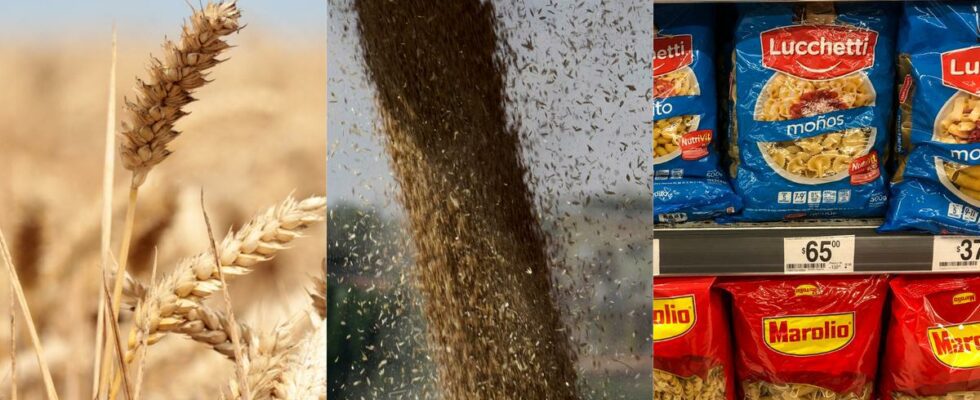These behemoths unknown to the public are not only intermediaries on the financial markets: they own land, supply seeds and fertilizers to farmers, buy their cereals then transport them by boat, store them, and resell them. AFP / CLAIRE MORAND / AFP / STRINGER / AFP / RONALDO SCHEMIDT
These companies, which have dominated global food supply chains for decades, made record profits in 2022 thanks to soaring prices.
They are four companies, as powerful as States, to dominate the world grain trade. THE “ABCD” have made windfall profits since 2021 thanks to soaring prices on wholesale markets and are accused of lacking transparency amid the global food crisis. The prices of wheat, corn or vegetable oils reached peaks in May 2022 in markets disrupted by the pandemic, then by the war in Ukraine. They have since come back down, but remain historically high. “Their power, often hidden, equals only their discretion”, sums up to Figaro Bruno Parmentier, engineer and economist, specialist in food issues.
But the Archer quartet Daniels Midland, Bunge, Cargill and Louis-Dreyfus – whose initials form the acronym “ABCD” – control “70 to 90% of world grain trade“recalls Jennifer Clapp, economist specializing in food security at the University of Waterloo in Canada. It is impossible to know the exact market shares shared by these four giants. Two of them are not listed on the stock exchange and do not publicly communicate the details of their performance. Not to mention that new players from Asia, starting with the Chinese COFCO, have come to compete with this historic oligopoly in recent years.
Read alsoCereal price inflation impacts French breeders
US giant Cargill, the world’s largest agricultural trader, soared to its highest in 157 years according to Bloomberg, hitting $6.68 billion in net profit at the end of its staggered 2021/22 annual financial year ended on May 31st. A figure up 35% over one year. These impressive results place Cargill again this year at the top of the largest unlisted companies in the United States, according to a benchmark ranking carried out by Forbes. In 2022, “exceptional year“, the American ADM posted a record net profit of 4.34 billion dollars, up 60%. “As the food and energy security of millions is at risk due to rising food and commodity prices, traders are making record profits“, denounced the Swiss NGO Public Eye in mid-January.
SEE ALSO – Junk food: a former agrifood worker alert
From “Dallas to Delhi”
“If they bought wheat in January 2022 for delivery three months later, before prices skyrocketed because of the war, they could then sell it at a much higher level“, explains Jennifer Clapp. The demand for cereals has not weakened since, and “we remain well positioned to capitalize on the upside opportunities ahead of us“, underlined in February Greg Heckman, CEO of Bunge.
Recalling that the companydoes not set commodity prices“, Cargill denies having “benefited from the crisis“. The group claims to have contributed to the stability of the global food system, while disbursing nearly $162 million in aid to humanitarian organizations. The ABCDs also highlight the explosion in their costs, from nitrogen fertilizers to maritime transport and fuels.
Read alsoWhy your groceries should cost you more from March
Because of “Dallas to Delhi“, as ADM says, these behemoths unknown to the public are not only intermediaries on the financial markets: they own land, supply seeds and fertilizers to farmers, buy their cereals then transport them by boat, store them, and resell them. . “It is impossible to say: “I will not work with Cargill or ADM“”, abounds Pat Mooney, founder of the Canadian NGO ETC and specialist in concentration in the agri-food industry. According to him, the “ABCDhave not fulfilled their basic functions. To know : “ensure food gets to the people who need it at a stable price“, believes Pat Mooney, despite”abundant public and private reservesof cereals.
Read alsoSkyrocketing grain prices jeopardize food security
In France, large retailers have been warning for several weeks of an explosion in prices – of around 10% – in their stores from March. The sector specialist Olivier Dauvers had used the expression “red marchto give the measure of what awaits customers, an expression that distribution professionals and politicians have somewhat relativized since. This sudden rise in prices would be the consequence of commercial negotiations between distributors and their suppliers on the wholesale price of goods sold on the shelves. The agri-food industry says it is forced to increase the prices offered to distributors because of the inflationary context it has had to face for more than a year.
SEE ALSO – Inflation: will the poor foot the bill?
